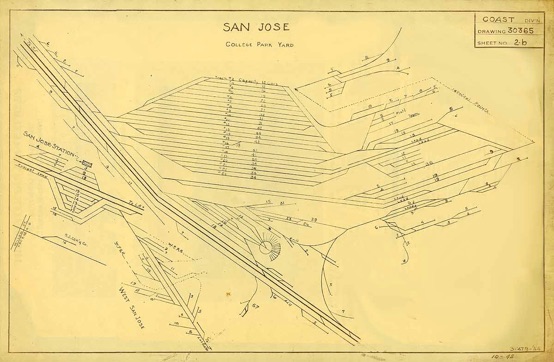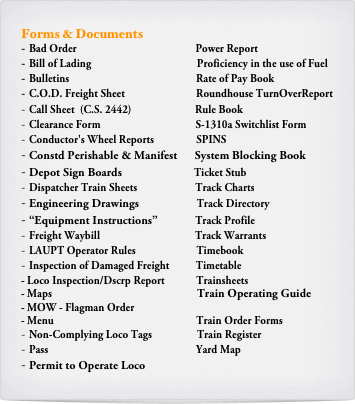Southern Pacific Lines
Coast Line Division
“The Route of the Octopus”
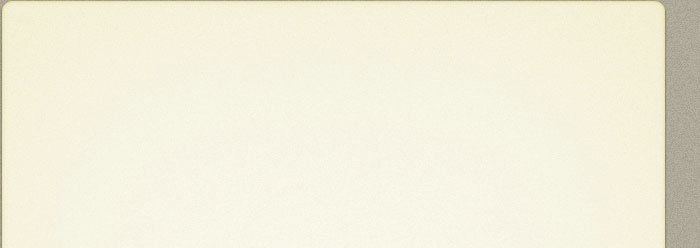
Southern Pacific Lines
Coast Line Division
“The Route of the Octopus”
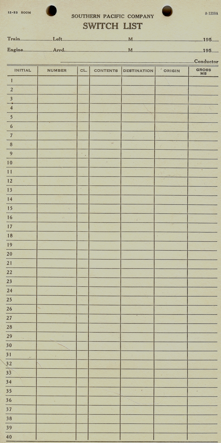
General
Below are examples of forms and documents mostly of interest to SP enthusiasts. They illustrate that before the days of “corporate image” created by graphics consultants, in which typography throughout a corporation would be squeezed into a single mold, different forms even in the same department could have different looks. They could and did change from time to time, and at any one time, a form might well not have the same typography.
Forms & Documents
Bad Order Defect / Non-Complying Locomotive Tags
They are bright orange and on one side it states caution defective items such as switches, hot boxes, axles or cars. The other side is for Non-complying locomotives. Only markings to designate the form is a CS-7058 and rev 7/92, there is a Southern Pacific lines sunset emblem on them. Tags are unused and have a 6 in piece of wire on them to hang onto said defective equipment. They are 6 1/2 x 31/4 in.
David Joslin
Bill of Lading
Here is an example of a Memorandum Bill of Lading. This is not the original Bill, but is intended to contain the information of an original, and can be used as a file record. This one is for normal shipper-billed cargo. It was originally green, though edges have faded toward yellow.
One interesting feature of many SP forms is that in the upper left corner is printed the date of printing the form, and the amount printed. For example, it might read “1-51-50M.” That means January 1951, and 50,000 copies printed. Accordingly, one can readily date any SP form which contains this notation. Also, the official SP number of that form is printed in the upper right corner. These forms have 1959 printing dates. Here is the upper left corner of such a form, and you can see the corner notation, “11-59-10M”.
Typography
Typographically, it is interesting in that it includes an SP emblem (the circle-and-bar at upper left) and the road name in a distinctive typeface. It’s a face very popular in the 1920s and 1930s, called Cheltenham, affectionately known among job printers as “Chelt” because it could be used effectively for most any task.
Former SP employees were directed to use up all of an old form before starting on the new batch, There may well have been SP waybills in use in 1953, still with Chelt headers. But in the 1950s, SP was changing many parts of its public image, including the substitution of sans-serif for serif typefaces.
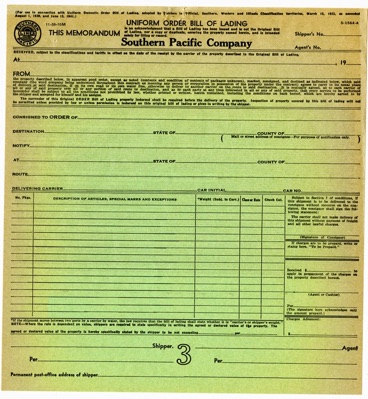
Modeling Bill of Lading
There may well have been SP waybills in use in 1953, with Chelt headers. Plan to use some examples with your model waybills.
Bulletins
Bulletins are notices affecting operating rules. SP Bulletins were pink in color and numbered consecutively. When the current timetable expired they all became void and it was necessary to start all over again with the number one. Bulletins covered such things as changes in the rules or timetables. They were posted at specified stations.
C.O.D. Freight Sheet
Here is another example of a Memorandum Bill of Lading. This is the companion one for COD freight, (Collection on Delivery). The parts relating to the COD are printed in red. These forms have 1959 printing dates.
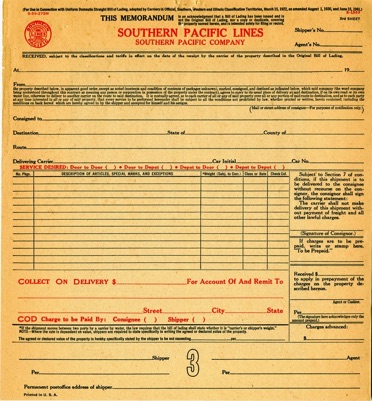
Engine Facility Call Sheet (C.S. 2442)
The Roundhouse Foreman is in charge of the roundhouse. He selects motive power for each train spelled out in the Engine Facility Call Sheet.

Clearance Form
Under the Standard Rules, a Clearance and a Train Order (TO) were two completely separate forms and were never combined into a single form. Once issued, a Clearance allowed a train to depart a station (whether a regular train, or an extra) after a specific date/time.
Eric Berman
Think of it like Clearance means train exists and has checked for orders. But at some registry stations you may need one too.
Jon C.
In TTTO a scheduled train would (or could) receive a clearance and no orders. It runs based on it's timetable times. ALL trains must receive a clearance. period. That's true for the initial station on a subdivision.
Jon C.
SP emphatically did NOT combine clearance and TO forms.
Tony Thompson
Note that the "cleared" train still had to comply with any / all restrictions imposed by the employee time table, special instructions, Standard Rules and any TO's (the last only if the cleared train was an extra), fixed signals, flagmen, etc.
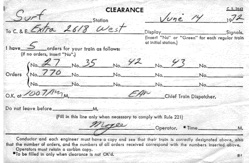
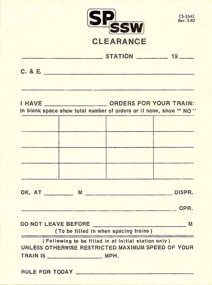
Conductor's Consist Record Book
Conductor's Wheel Reports
There is a document called Conductor's Wheel Reports. SP Pacific Lines was providing wheel reports from yard offices, printed out on Teletype machines, in the mid-1950s. The data handling was on machines with probably less computing power than your cell phone, and much data was on punched paper tape and punch cards.
Tony Thompson
Consolidated Perishable & Manifest
The Consolidated Perishable and Manifest schedules were put out infrequently by the Transportation department. Info not public.
Wesley Fox
There were different Manifest, etc. train schedules from the 1970s. The SP schedules are similar to the employe (sic) timetable format, on single sheets that are 24" wide and 18" high, suggesting that SP continued to prefer this format.
KWH
The earliest one I have seen is identified as GST No. 15.
Larry Castle
No. 23 is 1965, No. 24 is 1966, averaging one per year. there do appear to have been a whole bunch prior to 1965.
Tony Thompson
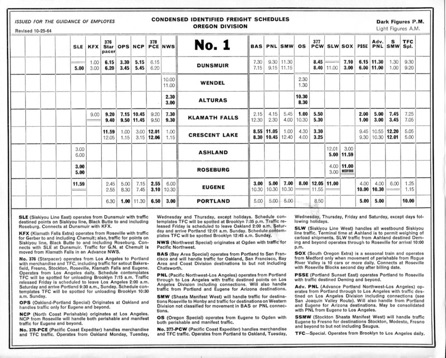
Reference
"Condensed Perishable, Merchandise and Manifest Train Schedule No. 15" and several other documents to the photo section.
These were all given to me by Jack Bowden, Shasta Division conductor retired. The manifest document had to be scanned in 4 parts because of its size. The folder is located at:
Larry Castle
http://groups.yahoo.com/group/Espee/photos/album/1572004347/pic/list?order=ordinal
Depot Sign Boards
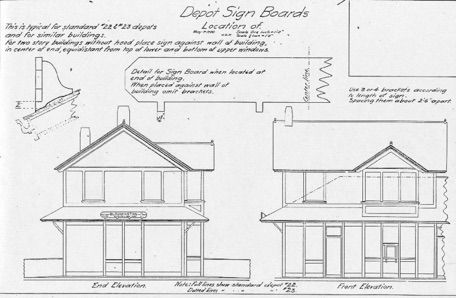
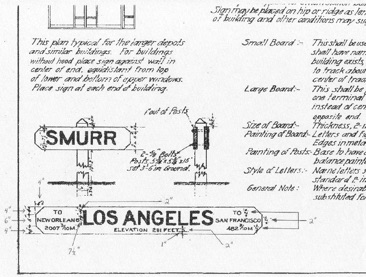
Diagrams of Steam Locomotives
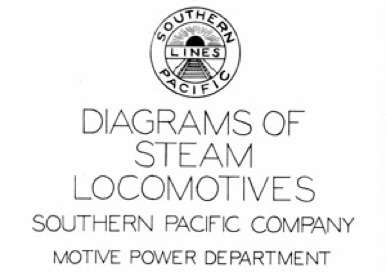
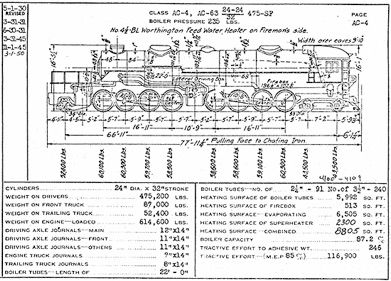
Dispatcher Train Sheets
(Ventura Sub-Division, Sept., ‘41) (*see Trainline - 28, pg. 6)
SP Engineering Drawings
From the Collection of Robert Bowdidge on Flickr:
http://www.flickr.com/photos/47871268@N02/sets/72157630008483840/
Bob Chaparro
Equipment Circular
They list passenger train consists.
“Equipment Instructions”
An important part of the handling of freight equipment on the prototype, certainly including SP, was the document known as “Equipment Instructions.” This was typically issued for an entire division, at intervals as needed (weekly or less frequently), and was associated with car handling.
This document did two important things, over and beyond the Car Service Rules: it instructed those receiving the document how to handle empty company cars as well as foreign empties (in particular, where they were needed and should be sent), and also identified any special needs for foreign-road cars to be returned promptly to their owners. An example of the latter might be that the C&O was experiencing shortages of coal hopper cars and needed all empty C&O hoppers to be returned as soon as possible.
Since these documents were frequently issued, the old one was normally thrown away in favor of the new one.
Modeling “ Equipment Instructions
With those SP documents of this type as guidance for language and format, I have constructed an “Equipment Instructions” letter for the Coast Division in 1953.
Using a typewriter font, I made this up as a two-page letter (typical size) and have placed it in Google Docs with this link:
You will notice that it separately treats company and foreign cars, and does refer to Car Service Rules for many situations.
One explanatory point: the instruction to promptly move empty ATSF and SFRD cars homeward may seem like “helping the enemy,” but numerous employees have stated that this was indeed the practice, likely to avoid any possibility of such a competitor’s car being spotted for loading by an SP customer. All indications I have seen are that Santa Fe and SFRD did exactly the same with SP and PFE empties.
The “Equipment Instructions” fill a gap in the methods and practices of car distribution.
Tony Thompson
Excess Hours of Service Report
Form 19
SP Form 19s from the early and mid-1950s, show SP emphatically did NOT combine clearance and TO forms.
Tony Thompson
Freight Express Bill
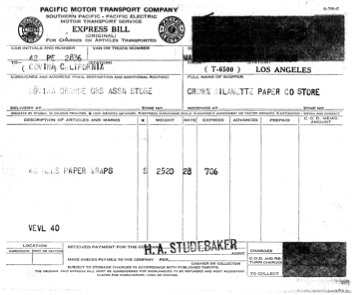
Freight LCL Receipt
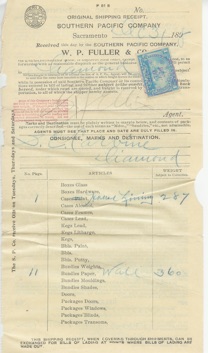
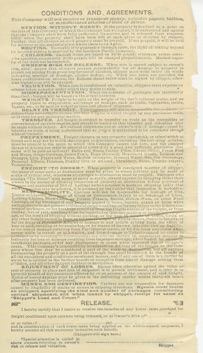
Freight Waybill
Prototype waybills not only show all the railroads over which the shipment will move, they also show the junctions at which interchange will take place. The latter is vital in returning empty cars via their service route.
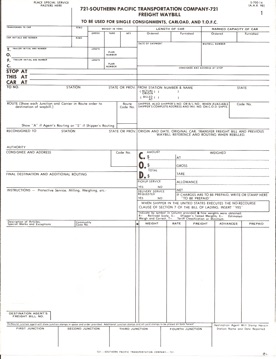
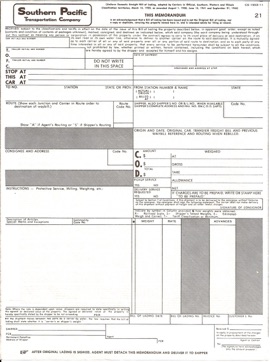
1958 printing date
Typography
Here the road name and number is a much lighter sans-serif face than on the Damaged Freight form.
Modeling Waybills (by Tony Thompson)
I began with some prototype waybills I had collected. These are available widely from sellers of railroad paper. They have also been printed in some books, notably in Freight Cars Rolling by Larry Sagle (Simmons-Boardman, 1960), and are part of the extensive collection of mandatory AAR forms in the Railway Accounting Rules book (AAR, 1950), published every few years by AAR. Both can be obtained through internet used-book sellers. I used the 1950 edition of the AAR book as most relevant to my 1953 modeling era.
Tony Thompson
"Prototypical Waybills for Car Card Operation," RMC, December 2009, pp. 71–77.
"Contents of a Waybill," The Dispatcher's Office (publication of Operations SIG), April 2010, pp. 17–24.
The DO article was intended to explain the various parts of prototype waybills, which is essential if blank waybills are to be filled out properly for model use. I have added a version of my waybill article from the April 2010 issue of The Dispatcher’s Office (pages 17–24) to Google Docs. Anyone is permitted to download and, if desired, print this document. See the following link:
Tony Thompson
My previous post on how I make my waybills, available at http://modelingthesp.blogspot.com/2011/02/waybills-4.html, showed the final result of the blank waybill that I’m using. This post is to correct possible misunderstanding of the first post I did on this subject, called “Waybills” in December 2010, at
I fill out the waybills using a variety of digital typefaces which look like prototype billing typewriter fonts (always completely in upper case). The font I’ve found which looks close to the SP’s billing typewriter is called Bell Gothic. I also use two typefaces which nicely suggest worn and dirty keys in a typewriter. One is called “Mom’s Typewriter” (literally digitized from the output of an old typewriter), available free at www.fontspace.com/christoph-mueller/moms-typewriter, and the other is called “Typenoksidi,” which Jeff Aley told me about originally, available free for personal use at www.dafont.com/typenoksidi.font.
Tony Thompson
Inspection of Damaged Freight
Here is an example of a Damaged Freight Inspection form, dated 1957.
Typography
In the 1920s and 1930s, Cheltenham was a very popular typeface. But in the 1950s, SP was changing many parts of its public image, including the substitution of sans-serif for serif typefaces. This is a quite different typeface for the road name than Chelt.
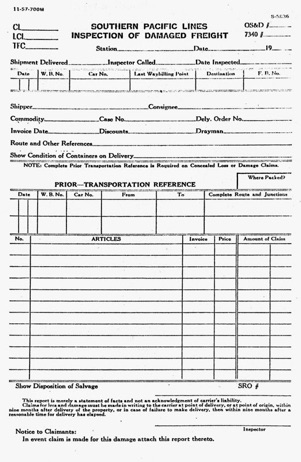
LAUPT Rules
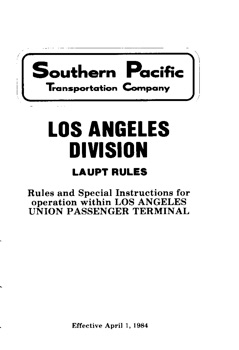
Locomotive Inspection / Discrepancy Report
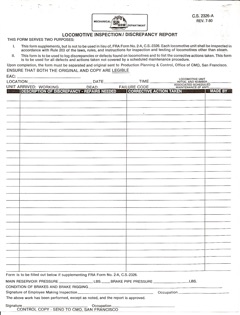
Map - Coast Line
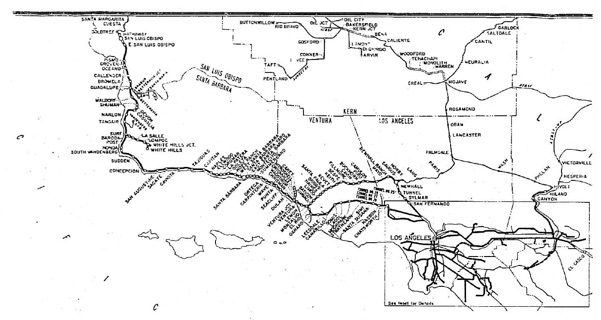
Map - Western Division
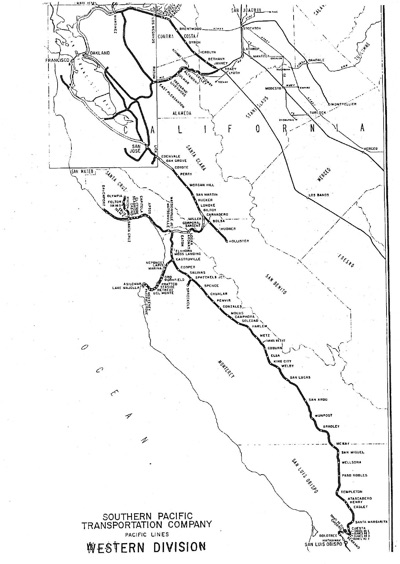
Meal Service Card (1948)
(*see PT2-200)
Menu
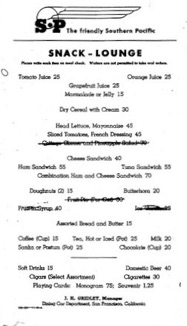
MOW - Flagman Order
From a Rules and Regs for a MOW and structures 1953 book.
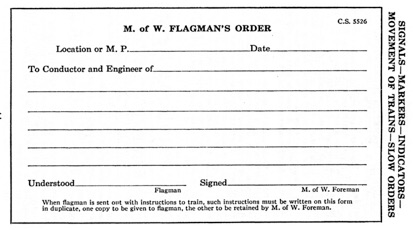
Non-Complying Locomotive Tags / Bad Order Defect
They are bright orange and on one side is for Non-complying locomotives. The other side is for caution defective items such as switches, hot boxes, axles or cars. Only markings to designate the form is a CS-7058 and rev 7/92, there is a Southern Pacific lines sunset emblem on them. Tags are unused and have a 6 in piece of wire on them to hang onto said defective equipment. They are 6 1/2 x 31/4 in.
David Joslin
Pass

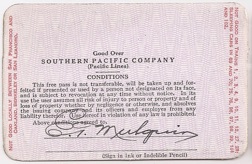
Permit to Operate Railroad Locomotive
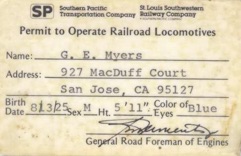
Power Report (LA, SF, ...)
Units entering the yard (Taylor, etc.) first pass to the jurisdiction of the roundhouse tower. As the power enters the yard the tower checks with the computer lists to determine what service level is required for each unit and whether any defects have been listed against them. Supervising this the roundhouse foreman works an extra 15 minutes on each end of the shift allow for a complete turnover repot. Each shift is in charge of the paperwork necessary to the completion of passing a unit through the service area. All of this is tracked on the "POWER REPORT LA".
Proficiency in the Use of Fuel Certificate

Roundhouse Turn Over Report
Units entering the yard first pass to the jurisdiction of the roundhouse tower. As the power enters the yard the tower checks with the computer lists to determine what service level is required for each unit and whether any defects have been listed against them. Supervising this the roundhouse foreman works an extra 15 minutes on each end of the shift allow for a complete turnover repot. Each shift is in charge of the paperwork necessary to the completion of passing a unit through the service area. All of this is tracked on the "ROUND-HOUSE TURN OVER REPORT".
Rules & Regulations and Rate of Pay Book (Telegraphers)
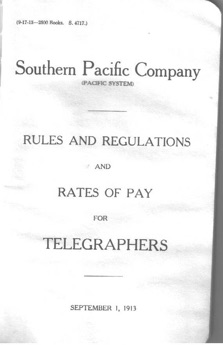
Rules & Regulations for the Maintenance of Way and Structures
January 1, 1953
Contains SP's Common Standards for roadbed and track profiles for single and double
track, also curves, CS 500, CS 502, CS 520, and CS 522.
July 1, 1968
Contains SP's Common Standards for roadbed and track profiles for single and double
track, also curves, CS 500, CS 502, CS 520, and CS 522.
November 1, 1976
The November 1, 1976 revision, has roadbed profiles in it.
Rules & Regulations of the Transportation Department
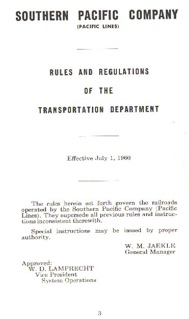
S-1310a Switchlist Form
These things were basically a heads up for the conductor of what was on his train.
There is no information to indicate the railroad other than the form number in upper right hand corner. Company issued switch lists for the SP, did not list the car type, only the AAR class. The form has a "printing date" along the lower edge.
Pat LaTorres
The clerks apparently took MANY liberties with filling them out (on typewriters, probably manual.) The waybills were the formal paperwork for moving the car. When things got computerized, the printed-out wheel reports replaced the typed-out switchlist and were much more standardized.
Lee A. Gautreaux
At least some SP switchlists continued to be hand written into the 1990s, depending on who made them up, but there were also computer printouts in use for that purpose in the 1970s.
Tony Thompson
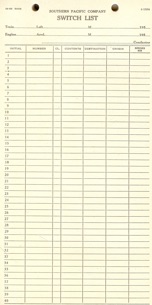
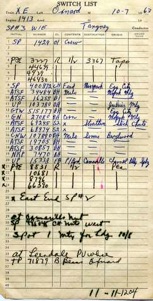
SPINS
SPINS booklets were published by the railroad and assigned specific numbers to industrial tracks and switching zones. They provide a general arrangement of tracks and industries served. SPINS identified shippers along with including car spotting information on the siding or tracks as required. An example of a couple SPINS pages is below and in the list's Files area, covering a small section of the San Francisco Peninsula, specifically the area around Menlo Park and Palo Alto.
http://finance.groups.yahoo.com/group/Espee/files/1974%20SPINS%20book/
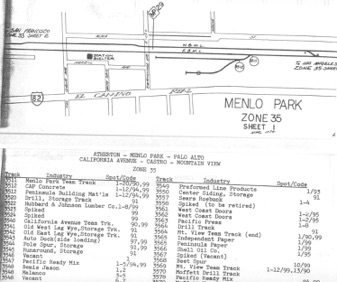
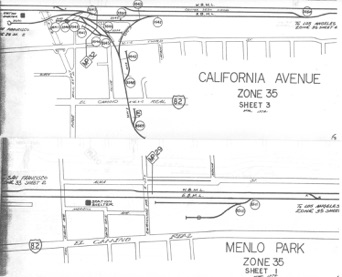
System Blocking Book
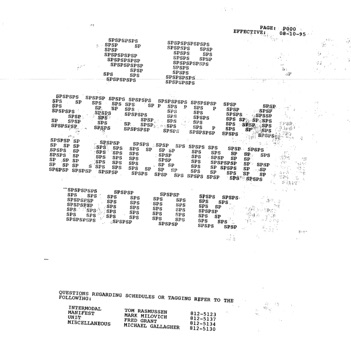
Telegram
Employees and managers communicated in different ways. There were three kinds of forms SP used internally for a number of years. These were called Telegram, Mailgram and Airgram.
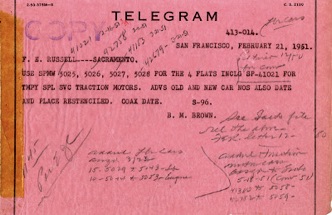
Ticket Stub
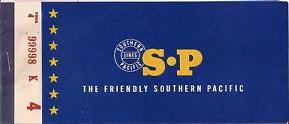
Ticket Jacket
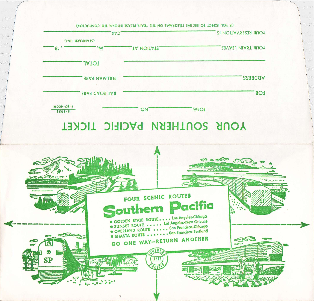
Timebook
The timebook contained job numbers and on-duty locations. Each entry in this book is a date, number in the 700-799 range, two letter initials, potential start time, and potential pay for the day.
Robert
On each shift you filled out a time slip and stamped it with your personal (issued by the company) rubber stamp that included your individual number. Engineers, conductors and switch foremen carried a pad of these long, yellow forms. At remote locations there was a box to put these in each day. A clerk came around periodically to collect them.
Barry Anderson
The following is a timebook owned by Chuck Catania. It's the 1949-1950 time book for a San Jose yardman.
http://www.vasonabranch.com/railroad/timetables/san_jose_1949.html
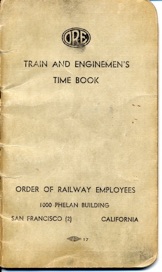
Timetable
The SP uses timetable notes on the schedule pages to make important trains such as the Coast Daylight superior to other first class train when it was running in the inferior direction. On the cover of the employee timetables there appears a number designation (190, 165, 2, etc.). These are sequential issue numbers, and each Division had its own sequence. Periodically, numbers would restart at 1, generally after some major changes in Division alignments or other important matters which dictated an issue with substantially changed data.
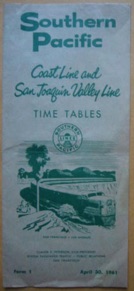
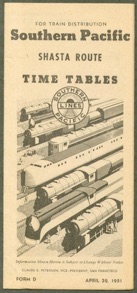
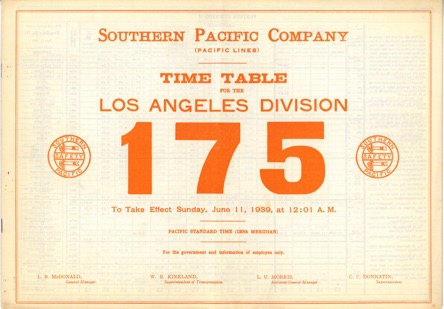
Track Charts
Southern Pacific and other railroads published books with detailed track arrangements often called Track Charts, the name may differ on other roads. Track Charts are the diagram of all/exact trackage in a certain location. (i.e. If looking for the chart of Taylor one would expect to see all trackage in the yard and associated).
Track Charts were produced by the railroad engineering department. They came in a bound binder, and had so much detail of the track on them that a full sheet was only able to show maybe FIVE miles of actual track distance. Some track charts are only 8.5 inches long and cover five miles. For comparison example, the representation of Sacramento requires about 1.5 inches.
Wendell Huffman
Some track charts come in many formats for both Pacific and Atlantic lines systems. One track chart from the 1950s has a page count of more than 1000, and that is just for the Pacific Lines!
Ken Harrison
These are detailed drawings developed by the railroad and include numerous engineering specifications for roadbed, track, bridges, crossings, culverts etc. containing technical data about those structures. On them, the main line is presented as a straight line across the page, with track data noted in parallel presentations. The track representation looks much like what one would expect to see on a CTC board. These charts do show curvature and grade--but only by data, not by scale graphic representation (they show a darker line on one side of the track or the other depending upon direction of curve).
Wendell Huffman
Besides the track and grade profiles, these "charts" showed:
type of rail used (including weight) and when it was put down
ballast types applied and when (sometimes includes the source)
gradient
undercutting dates
switch sizes (No. 10, 12, 16, 20, etc)
bridges locations and types (broken down into span types, number of each and length) i.e.deck girder
culverts
crossing protection type and DOT numbers
direction of curves and the degree of curvature and length of curve, etc.
signal location and type and assigned number
signal maintainers location
siding lengths by car capacity
roadmaster (with names)
section headquarters
speed limits
SP pipelines
And everything else that someone from the engineering department would need and understand.
Patrick Flynn
Reference
The West Coast rRail Forums site has posted numerous SoCal SPINS.
http://www.railfandepot.com/servlet/the-2248/Southern-Pacific-track-chart/Detail
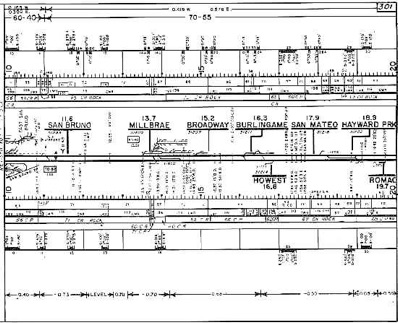
Modeling with Track Charts
These books are valuable for modelers wishing to recreate specific segments of the railroad. If you want to model something specific, they can’t be beat! http://stores.ebay.com/RailfanDepot
Track Directory
It includes a list of industries, locations, and capacities. It also includes a key for tagging cars with two digit numbers for routing.
1931 San Jose SP Track Directory
Ken Middlebrook shared a scan of a 1931 SP track directory for San Jose. His list has as well a phone list for the SP San Jose employees. The original is in History San Jose's collection. Routings were San-Jose centric; they had numbers for each of the local zones in yard limits (which match the 1970's era SPINS zones for San Jose), and a separate number for (I assume) each local. Campbell to Santa Cruz got its own number, the New Almaden branch got its own number, and "Lawrence and Atherton" got its own number.
http://www.vasonabranch.com/railroad/timetables/index_assets/1931%20SJ%20Track%20Directory.PDF
http://vasonabranch.blogspot.com/2011/12/teasing-out-operating-details-from.html
Track Profile
Profiles often show more than a vertical "cross section" of railroad. Early ones give curve data (in some cases several generations of curves as lines were straightened), bridges, culverts. Old track profiles on the CP line show now long-forgotten place names, and from Brown's to Promontory show the location--to the foot--of the end of track on each day of original construction. These early profiles were "working documents" and note changes in rail hardware, dates tie plates were first installed, dates for tie renewal, fence lines. Profiles appeared in the ETT, showing gradients.
Wendell Huffman
Roadbed
These are drawings for single and double track, 8" and 12" ballast.
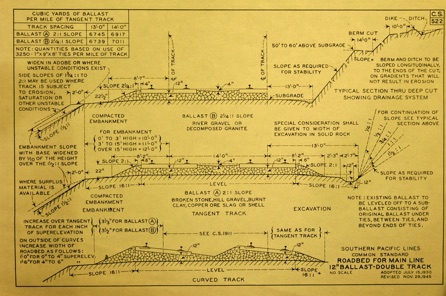
Reference
Drawings
More of these can be seen in the Espee Yahoo Groups File Folder.
Ernie Frisch
The track profiles for secondary Main and Branch Lines is in volume 2 of the Common Standard Plans Books.
Track and Right of Way Map
They were drawn at 400' to the inch, and roughly five miles of straight line would fit onto the 60" long sheets. They show property lines (and when and from whom each parcel was acquires), all trackage, engineering stations, BC, CC, and EC points of curves, as well as other curve data, culverts, bridges, road crossings, and railroad structures. They do not show grades or anything about rail or ballast. As an example, Sacramento requires several sheets. (There are also Station Maps drawn to 100' to the inch.)
Wendell Huffman
Track Warrant
In 1985 the SP switch from TTTO to Track warrants on the coast line.
Wesley Fox
SP used DTC from 1985 to the end.
Trainsheet
The dispatcher records on Train Sheets each time a train passes a check point.
8/53 (*see T-33/9)
SP Train Operating Guide or (SP System Blocking Book)
(Two different titles in two different places) effective 5/15/92 which covers the entire system including the former DRGW and the Cotton Belt. The original is in a three ring binder with a red and gold Southern Pacific Lines herald slipped into the pocket on front.
The book is divided into sections: Train Identities, Origin & Destination Codes, Block Names and Tag and Station Numbers.
It then lists all of the trains from the ADHFT3 (Kansas City to Nogales) to the WSWCM (Oakland to West Colton via the Coast Line) with all symbols in between listed in alphabetical order.
Under each symbol is found blocking instructions, designation of 1000 mile inspection points, types of cars to be handled or not handled(in the case of speed restricted or hazardous cars). Of course the schedule showing location name, arrival and departure times and mileage are listed.
Train Order Forms
Tower operators pass along Train Orders to the train crew. To pass on train orders, his station has a train order signal to indicate to the crew to pick-up the train order. In TTTO a scheduled train would (or could) receive a clearance and no orders. It runs based on it's timetable times. ALL trains must receive a clearance. period. ALL Extra trains would require at least one train order in able to move. A scheduled train does not.
Jon C.
SP emphatically did NOT combine clearance and TO forms. The company name and safety emblem were by no means standard in the early 1950s, and in subsequent years.
Tony Thompson
Actually regular trains could and often did get train orders. Wait orders being one common type as well as slow orders being another.
Dennis Drury
TO's were only issued to extras (i.e., not a regular train), but did not perform the function of a Clearance form.
Eric Berman
At intermediate TO stations, if there were no orders for that train then no clearance was needed.
ALL Extra trains would require at least one train order except in D-97 territory, which SP double track usually was.
Regular trains did receive train orders, as well as clearance cards. From 1943 and 1969 the following definition: "Regular Train. A train authorized by a time-table schedule."
Cliff Prather
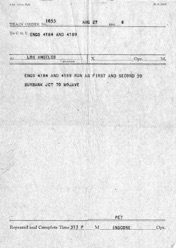
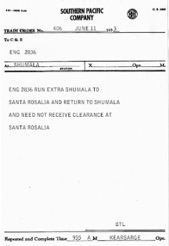
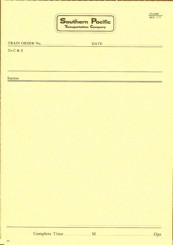
1948 1953 1969
Annulling Order
An order annulling a scheduled train, and requires it to operate (if it is run at all) as an extra.
Slow Order
A train order can even change the terms of the schedule under which the scheduled train is operating, such as changing the meeting point with other scheduled trains.
Modeling Train Order Forms
Both the Kalmbach books on operation are equally good, though one is out of print (readily available used from on-line dealers). Currently available is Tony Koester’s Realistic Model Railroad Operation (2003). The other one is Bruce Chubb’s How to Operate Your Model Railroad (1977), an excellent and comprehensive book, and well worth seeking out.
Tony Thompson
Train Register
A “train register,” is located at critical points, often at terminals or important junctions. Crews sign it when arriving or departing, and its purpose is to show that scheduled trains have in fact departed or arrived (since timetable authority continues for 12 hours after the time shown in the timetable, there would otherwise be no way to be certain of such arrivals or departures).
Tony Thompson
Yard Map
